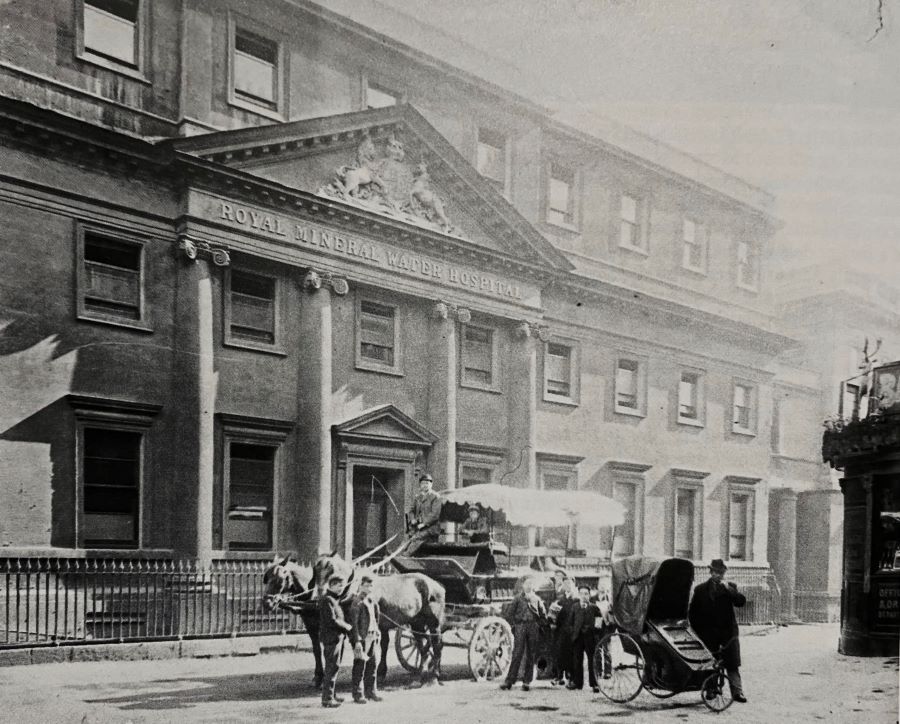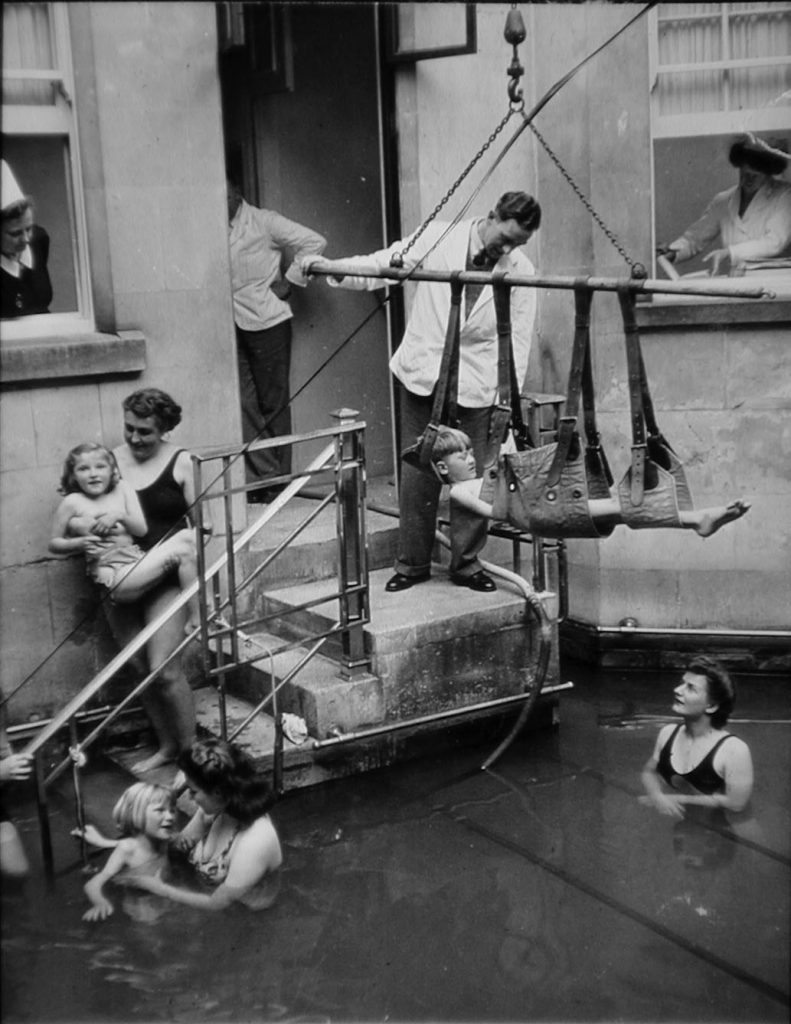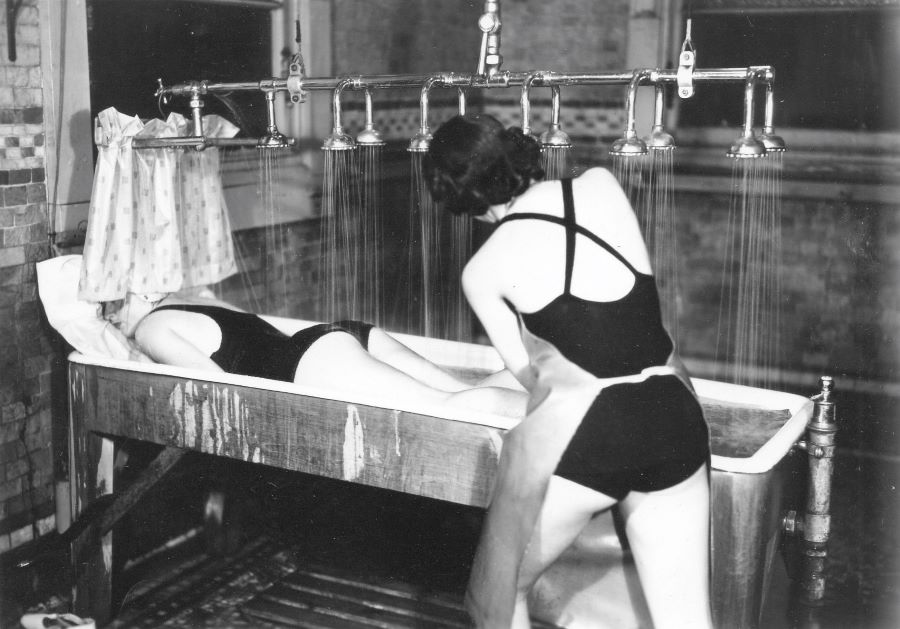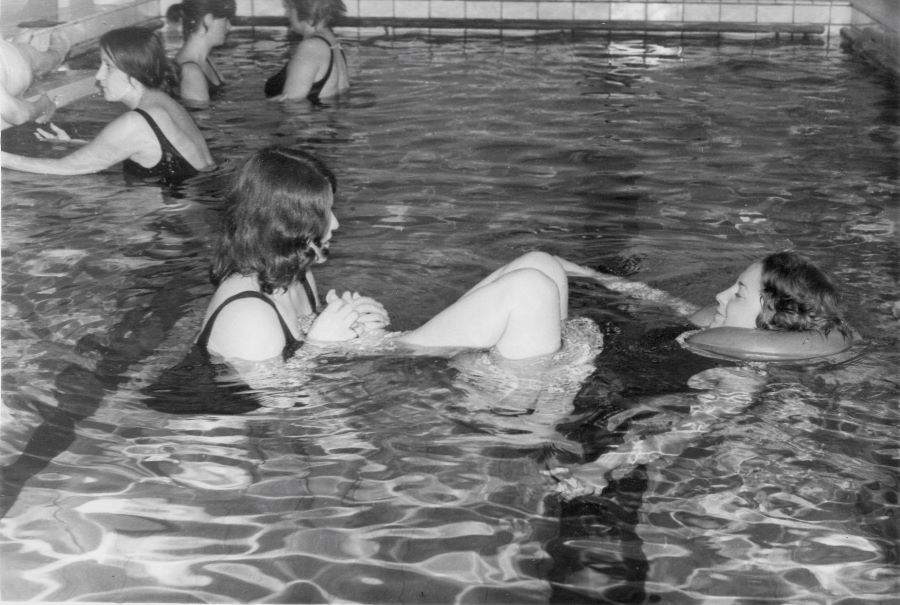Bath Medical Museum is indebted to Margaret Dyson (nee Craig), a retired physiotherapist who has contributed her papers and books relating to a remarkable hydrotherapy training course that she attended. The course was held in Bath at the Royal National Hospital for Rheumatic Diseases (known to Bath residents as ‘the Min’), in 1976. This article summarises the context of the development of hydrotherapy, before reflecting on the training course content.
What is Hydrotherapy?
Hydrotherapy is any method that uses water to treat a range of symptoms, chronic medical conditions, and disability. It can also be used to treat more acute conditions such as postoperative joint replacement. The techniques used may vary from simple baths to very skilled and targeted movement and strengthening of a patient’s body in water, carried out by a trained professional. This form of therapy has increasingly involved an understanding of the interaction of a range of forces in a water environment – buoyancy, drag and inertia, plus hydrostatic pressure, and the specific heat of water. The water temperature used in treatments is generally 33 to 36 degrees centigrade. The benefits of hydrotherapy have been understood and acknowledged in broad terms since ancient times – records date back to the Egyptians, Greeks, and Romans – with knowledge and practice developing through historical periods in many parts of the world, to the present day.


The city of Bath in the UK inevitably became internationally known for hydrotherapy treatments or ‘the water cure’ that deployed the natural warm spa waters, rich in minerals, emerging in the heart of the city. The Romans had constructed the complex of baths that gave the city its name. Therapeutic bathing and treatments became promoted and fashionable from the 17th century onwards with the Bath Spa being the significant focus for visitors. In the 20th century aspects of the Spa were functioning at the Hot Bath, the Tepid Bath and the lesser Cross Bath.
Patients at the old Royal National Hospital for Rheumatic Diseases located on Upper Borough Walls in the city substantially benefited from treatments at the Spa – the hospital, popularly known as ‘the Min’, opened in the centre of Bath in 1742 and functioned for 280 years until the building was sold by the National Health Service.

After the First World War, thousands of soldiers were rehabilitated in Spa towns such as Bath, leading to developments in treatments that combined water therapy with other medical treatments. During the polio epidemic in the 1950s, hydrotherapy was used in the rehabilitation of children paralysed by the disease.
Unlike the simpler forms of aquatic therapy, hydrotherapy may include other methods such as heat packs, cold packs, electrical stimulation, ultrasound waves or massage.
Forms of hydrotherapy were also used to treat mental illness in the early decades of the 20th century in the UK, Europe, and America. Those treatments characteristically involved use of steam cabinets and ‘wrapping’ or swathing patients for long periods in wet sheets. They became subject to question in relation to the level of evidence regarding patients’ improvement and their inhumane use as patients who were often coerced into submitting to such practices.
Hydrotherapy in the 1970s
In the 1970s and 1980s there were a proliferation of features and articles about the health benefits of hydrotherapy treatments, drawing on detailed and scientifically based studies. In addition to specific research studies focusing on the alleviation of a range of chronic diseases and disabilities, professional practitioners were building on their understanding of the physiology of immersion. Their insights not only drew on the known advantages of the weight bearing property of water – they were also developing knowledge of hydrotherapy exercises that exploited the body’s resistance in water. Such exercises are valued by hydro therapists treating patients and by athletes, after bouts of intense training or sport events.
The ’Min’ hospital in Bath had a hydro pool, newly built in the 1970s, five feet deep, for patients with an array of orthopaedic, musculoskeletal, and neurological conditions, with dedicated therapists offering one to one sessions or adapted exercise classes. The Min’s history and the facility of the hydro pool made it an ideal venue for a course for hydro therapists, based on experience and scientific observation, that was held there in the 1970s.

The Bath Hydrotherapy Course
The course was offered by the Bath School of Physiotherapy. Each course was designed to train six qualified Chartered Physiotherapists, who were selected by submitting a C.V., followed by an interview.the course lasted for six months and it was full time – the participants worked as physiotherapists on the wards or in Outpatients for half of each day, then attended the training for the second half of the day. Participants’ attention was drawn to every consideration relating to their work with patients in water – preparing patients beforehand, techniques to be used during immersion and caring for patients after treatment, all including awareness of their patient’s emotional response to immersion and movement in a hydro pool. Course content enhanced understanding of a number of medical conditions and disabilities.Students learnt to assess contraindications in relation to a patient being immersed in warm water, how to get them into and out of the pool, and the appropriate use of a range of aids.
At the end of the course there were theory and practical examinations and each participant had to submit a detailed project. Options for project work by the therapists attending the course included pool design, treatment of neurological conditions in water, comparison of pool therapy techniques and design and use of buoyancy aids

Another project option was the Halliwick Method, an approach to teaching all people, especially those with physical and/or learning difficulties, to participate in water activities, to move independently in water and to swim. Its programme was based on a knowledge of hydrostatics, hydrodynamics, and body dynamics.
The Bath Hydrotherapy Course was set to a high standard and contributed to the professional acceptance of hydrotherapy. It enabled experienced physiotherapists to be recognised as competent practising hydrotherapists. Margaret Craig, who contributed her course material to the Bath Medical Museum, was awarded her Certificate with Credit on 7th January 1977.
Research Insights
Ironically, astronaut’s training for zero gravity conditions led to a fuller understanding of the physiological impacts of immersion, whether musculo–skeletal, or the less understood impacts on organs of the body and soft tissue.
Therapists’ and patients’ experience was complemented by research trials. A controlled trial of hydrotherapy with rheumatoid arthritis patients recorded not only improvements in pain relief and joint movement – but also lasting improvement over a sustained period (1).
An overview appraisal of over 30 relevant research studies and trials was published in 2002. That study (2) concluded that the balance of high to moderate quality research evidence supported benefit from hydrotherapy in pain, function, self – efficacy and affect, joint mobility, strength, and balance, particularly among older adults, subjects with rheumatic conditions and chronic low back pain.
Developments in hydrotherapy have inevitably continued to evolve. A further innovative study day held in Bath in 1999, organised by the Hydrotherapy Association of Chartered Physiotherapists, presented ideas on the therapeutic use of immersion in water, combined with music and theatre. Hydrotherapy has for a prolonged period, reflected the value of a holistic therapeutic approach to well-being – an exceptional approach in an age characterised by an increased focus on specialist clinical practice.
Article by Linda Watts

References
(1) Hall J., Skevington S., Maddison P., and Chapman K. (1996). A Randomised and Controlled Trial of Hydrotherapy in Rheumatoid Arthritis, in Arthritis & Rheumatism, Vol 9, Issue 3, pp. 206-215.
(2) Geytenbeek J. (2002). Evidence for Effective Hydrotherapy, in Physiotherapy, 88, 9, 514 – 529.